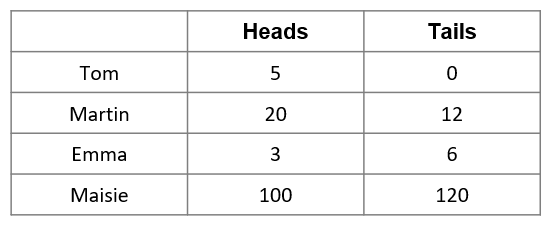Question 1
Tom, Martin, Emma and Maisie all toss a biased coin a number of times and record their results in the table bellow.

Using the results from Martin only, calculate the relative frequency of achieving heads on a coin toss.
Select the correct answer from the list below:
A: \dfrac{3}{8}
B: \dfrac{5}{8}
C: \dfrac{3}{4}
D: \dfrac{3}{5}
CORRECT ANSWER: B: \dfrac{5}{8}
WORKED SOLUTION:
Martin conducts a total of 32 trials.
Out of these 32 coin tosses, the coin lands on heads 20 times.
Hence the relative frequency of Martin flipping a coin and it showing heads is \dfrac{20}{32}=\dfrac{5}{8}
Level 4
Question 2
Tom, Martin, Emma and Maisie all toss a biased coin a number of times.

Use the information in the table calculate the most reliable relative frequency for a coin toss resulting in tails.
Select the correct answer from the list below:
A: \dfrac{3}{8}
B: \dfrac{2}{5}
C: \dfrac{5}{9}
D: \dfrac{6}{11}
CORRECT ANSWER: D: \dfrac{6}{11}
WORKED SOLUTION:
Maisie conducts a total of 220 trials.
Out of these 220 coin tosses, the coin lands on tails 120 times.
Hence the relative frequency of flipping a coin and it showing tails is \dfrac{120}{220}=\dfrac{6}{11}
Level 4
Question 3
Tom, Martin, Emma and Maisie all toss a biased coin a number of times.

Tom, Martin, Emma and Maisie all calculate a relative frequency for the result heads in a coin toss.
Which of the relative frequency’s calculated will be closest to the true value?
Select the correct answer from the list below:
A: Tom
B: Martin
C: Emma
D: Maisie
CORRECT ANSWER: D: Maisie
WORKED SOLUTION:
That with the greatest number of trails is likley to be the closest to the true value.
Level 4
Question 4
An unknown number of counters are in a bag.
A counter is removed, the colour noted down and then the counter replaced.

Use the table above to calculate the relative frequency of drawing a red counter from the bag.
Select the correct answer from the list below:
A: \dfrac{1}{5}
B: \dfrac{4}{5}
C: \dfrac{1}{10}
D: \dfrac{1}{4}
CORRECT ANSWER: A: \dfrac{1}{5}
WORKED SOLUTION:
The relative frequency of picking a red counter \dfrac{20}{100}=\dfrac{1}{5}
Level 4
Question 5
An unknown number of counters are in a bag.
A counter is removed, the colour noted down and then the counter replaced.

Use the table above to calculate the relative frequency of drawing a yellow counter from the bag.
Select the correct answer from the list below:
A: \dfrac{1}{5}
B: \dfrac{3}{10}
C: \dfrac{4}{7}
D: \dfrac{5}{6}
CORRECT ANSWER: B: \dfrac{3}{10}
WORKED SOLUTION:
The relative frequency of picking a yellow counter \dfrac{30}{100}=\dfrac{3}{10}
Level 4
